Note (16th May 2020): Due for update. Some sections need to be expanded and inaccuracies removed.
In this post is a my overall take on the Vosmaeri, an in-depth look at the appearance differences between a pure and a crossbred bird and the similarities between the Vos and Aruensis males. Prepare for text wall and picture spam! All the photos I’m using here are my own, or belong to friends (with permission). None are sourced from the ‘Net.
The Internet has plenty of insightful articles but some friends would rather hear from someone they know. Just remember that some people / shops will say or do anything for money so always cross-reference with other sources.
The following is based on a local context. Singapore.
The E.R Vosmaeri. The most intelligent of the 4 available subspecies here and arguably the best in appearance, although it is regrettable that people do not value the male as much as the female. Both male and females are excellent talkers, especially so the females whose nature enhances that ability.
Ridiculously hard to keep in terms of dedication. Due to their intelligence and being extra sensitive, one wrong move and the bird could lose its feathers. I’ve been there. A new brand of pellets. Toe tapping, wing flipping and feather loss. An empty food dish – snipped feathers. A medal should be given to local owners who manage to keep their bird fully feathered throughout their entire life.
They are quiet, until maturity. Loud but not noisy as the Solomons which are softer and produce more frequent calls.
In 2014 I saw with my own eyes a pure Vos female and fell in love.
Many people do not care if their Vos are pure or not. Understandable from a pet and hobbyist point of view. But that does the species no good and inevitably when that impure or crossbred bird matures and takes a liking to another subspecies……
There are a few things to look out for when acquiring a pure Vos. It is easier to identify a pure female over a male so let’s go into that first.
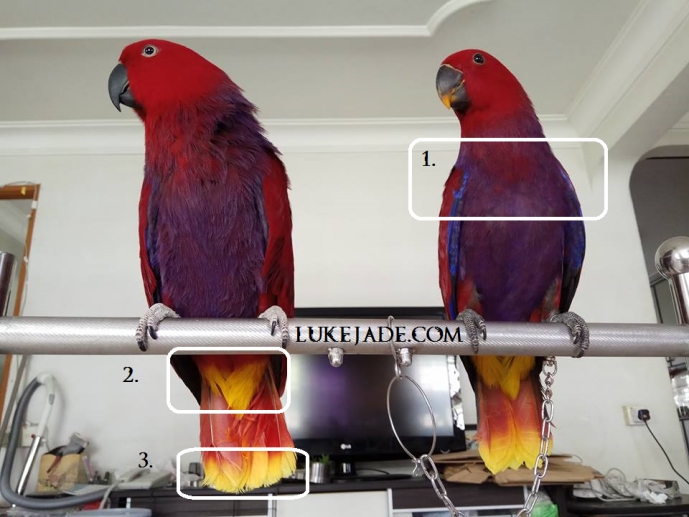
I had to butcher that nice photo. Left is a mature bird, right is a youngster.
- There is no definite distinction between the red and lavender chest feathers (or a bib).
- The vent feathers are a pure yellow.
- There is at least an inch of yellow on the tail top side (circled is under tail).
So here is a close up of a pure bird vent and tail. It’s the right bird on the photo above.

Splendid isn’t it? And it’s only a 2 month~ youngster. At 6 weeks old I was certain that she is a pure bird with a large yellow vent and a lack of a defining bib.


Some pure birds have a tinge of red on the yellow vent feathers.

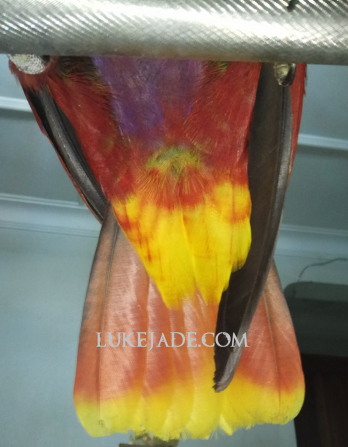
So you would need to look at all three criteria for purity. The two tails above are of different females:
 <- Left
<- Left
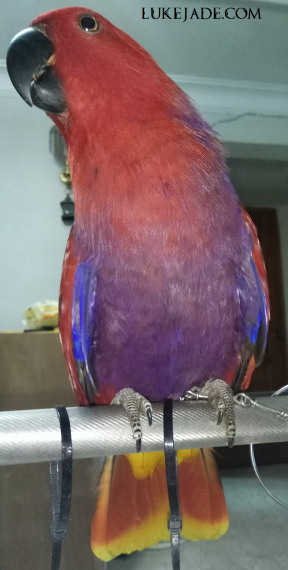 <- Right
<- Right
Now let’s look at the tail. Pure females have at least an inch of yellow tail.
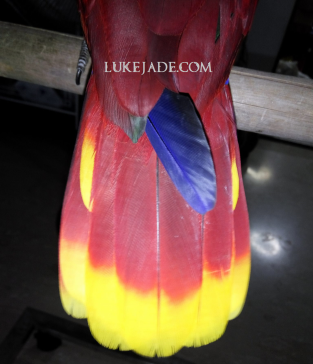
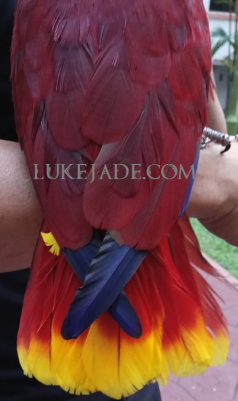
 (All 3 are different birds)
(All 3 are different birds)
That inch of yellow comes as a chick. It does not develop only later! Same goes for the yellow vent and lacking in bib, all these qualities are present in pure female chicks.
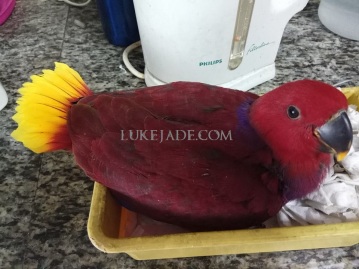
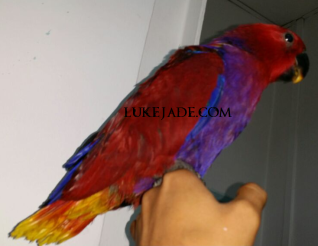
 (All three are different birds)
(All three are different birds)
I have come across cases of sellers telling people that the yellow tail grows later and that is not true of a pure Vos female!
The amount of yellow will increase with the first few successive molts as the bird reaches maturity but it must begin with no less than an inch as a youngster.
Now you know the 3 identifiers of a pure female, let’s have a look at the impure or crossbred ones. Beware that there are some VERY nice crossbred female Vos around and it is easy to get confused.
This is the chick I first had. The father was a Vos as I was told by my mentor (a friend who had been breeding for many years and the source of some of my initial pairs) but he did not say if it were pure or not. The mother was a normal Red-Sided from a local farm.
The father had a Vos partner previously but she flew away before success.
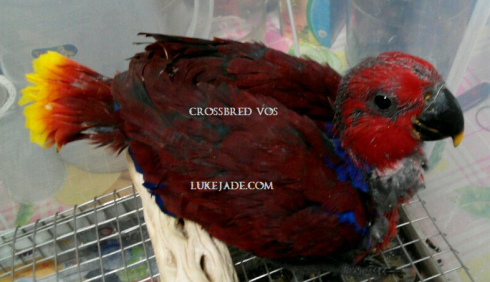
This chick, she had a blue-purplish chest as a baby which turned more blue as she grew. You can see her defining bib too as she feathered. She is also darker red than a pure female.


I have observed that crossbred Vos female chicks may decrease or increase in yellow tail amount. A pure Vos chick does not lose any yellow in it’s tail.
So how did that chick look like once it got older? As you can see below…the lovely yellow as a chick shrank. Her shade of red was still brighter than a Red-Sided but nowhere near a pure Vos’.
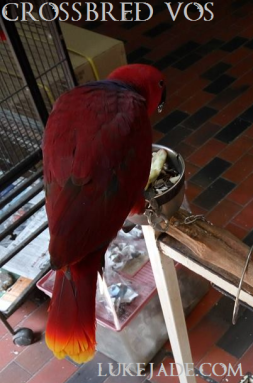
There was another crossbred Vos youngster I met in a farm. It had no yellow on it’s tail at all when I first saw it. Even the vent was red, if you can zoom in.
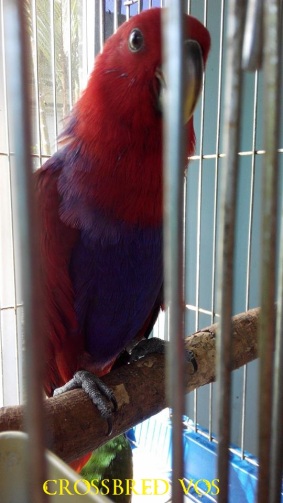
A friend took over ownership of that one and kept it for a while.
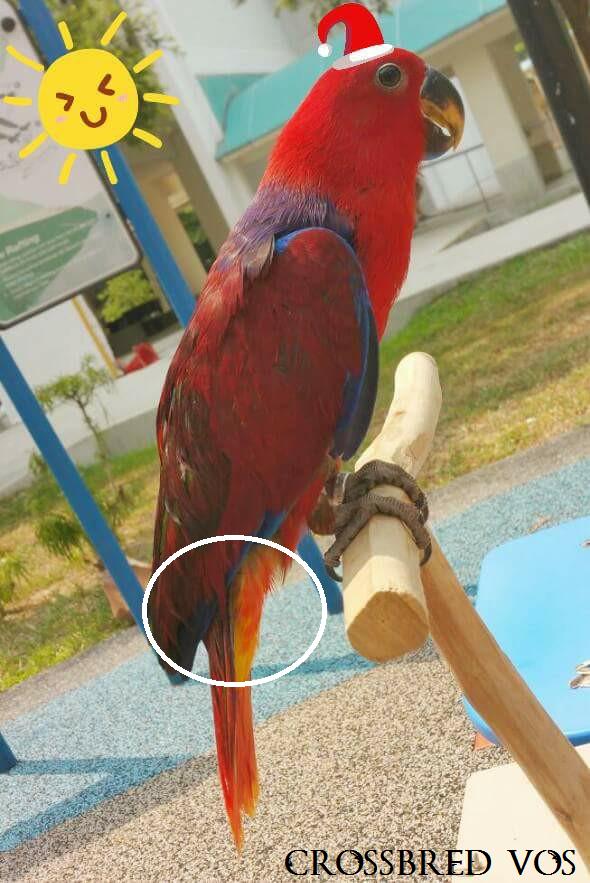
I decided not to shrink that picture so as to give a better look at the vent. Compare that with a pure bird at the beginning of this post. That’s literally the biggest sign of a crossbred Vos. This female grew yellow tail feathers during a moult and her vent became yellower!
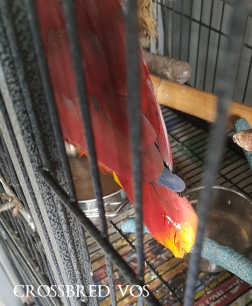
Crossbreed birds come in many different variations. Here is an example:
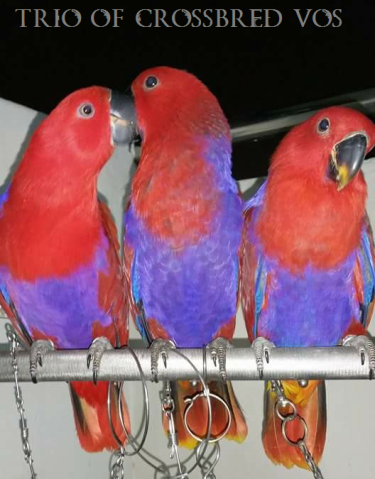
Left has a purple chest but no yellow tail. Middle is my first chick as depicted at the start of this section, with a smaller bib and tinge of yellow tail. Right is the same bird above that my friend took over with a red-yellow vent and slight yellow tail. None of them had a blue eye ring.
The same parents of the middle bird produced another female with a yellower tail. I had the opportunity to take a photo of her next to a pure female.


Once again there is a definite distinction between the red and purple feathers forming a bib, predominantly red vent and limited yellow on the tail. The shade of red is darker. Her chest and nape colour is also more blue.
If you are wondering why I didn’t just stick that pair picture at the beginning and call it a day, I thought I would drill in the photos of pure birds first then show the crossbreds. When you first appreciate the beauty of a purebred, anything else becomes less so. Then perhaps you will understand why many people including me, push for purity. It is not only about appearances but genetically there is also a need to preserve them.
A photo of a tail feather comparison of the two birds above:

Alright, on to some nicer crossbred females. The above are obvious crossbreds and then there are some that leave you scratching your head.
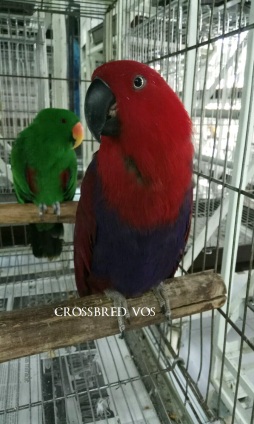
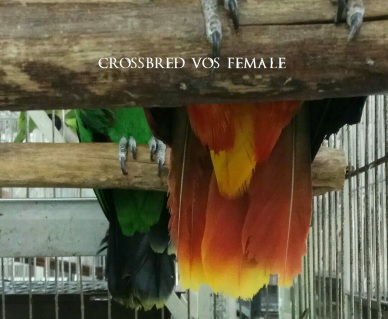
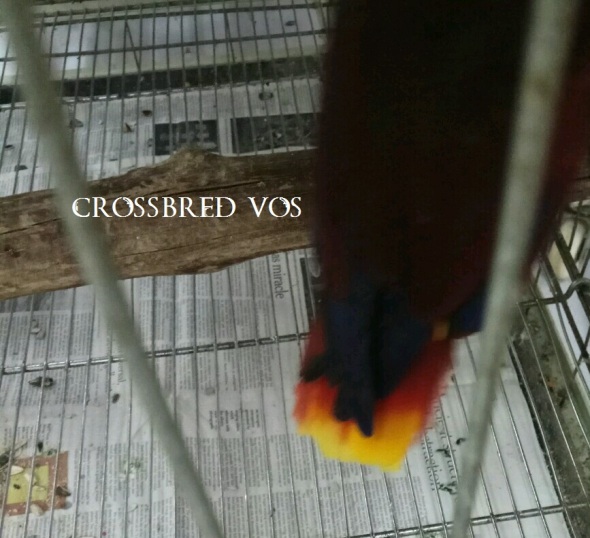
I took the above at a bird shop. I asked and was given permission. The female above had a beautiful yellow tail. I’m not that proficient at taking photos but she had about 1.5~cm of yellow.
A crossbred bird’s tail usually has a darker shade of yellow if present and often goes from orange to red gradient. Observe that the female above also has a bib. And of course heavy red in the vent feathers. But a lovely bird all the same.
Here is my favourite example of how beautiful certain crossbred Vos can be:

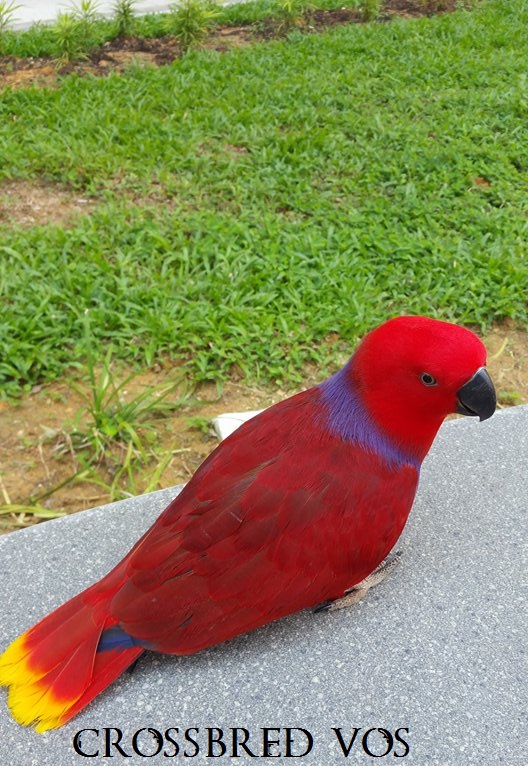
She has a fine yellow tail that’s for sure. Bright red too. And her chest does not look like it has a clear division of two colours. But there is a bib. For years I thought she was a pure bird until I sought a Vos from the same farm she was from and to double check, asked Rudy Caccia – an Australian aviculturist well equipped with knowledge of eclectus especially Vos – and I was stunned.
I spoke with the owner later and he sent photos that proved Rudy right even if I had not believed him completely at first. Here, a look at the bird when it was younger:
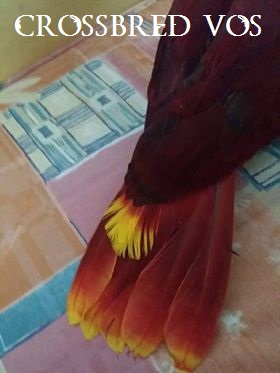


I also managed to retrieve an old photo of the bird’s vent recently and look at it! It is completely yellow without any red. The only thing is that it is a dull yellow opposed to a bright yellow in a pure bird. It is amazing. Her bib is very definite here and also the lacking in yellow tail.

A friend later bought a female Vos chick from the same farm and sent me a picture of her vent:

The tail tips look like the tail of the other bird above doesn’t it? Unfortunately this youngster died shortly after, so there is no chance of seeing how yellow its tail could have grown.
Now onto the males. In order to determine a male Vos’ purity you need to look at his sister or his offspring assuming the female partner is pure. That’s it. Lesson over.
I do not have many photos of local pure and crossbred male Vos, due to the lack of popularity few people keep them.
The first thing you see about a pure Vos male is the length of the bird. He is very long and most streamlined of all the subspecies here. Note that I mention long and not wide. Some people say Vos are big sized due to their length. But they are not bulky-big.
The length of a pure male Vos comes from his slender body and long tail.
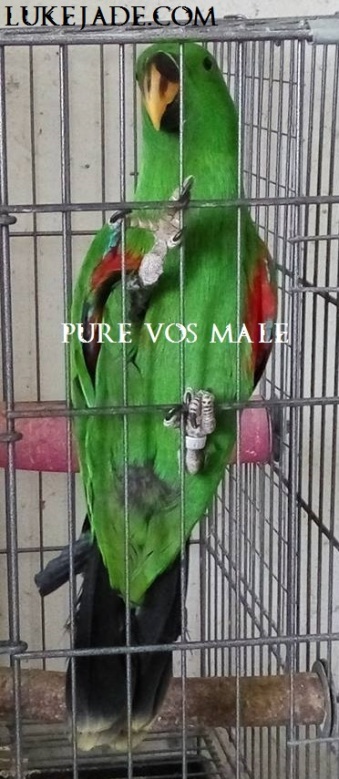
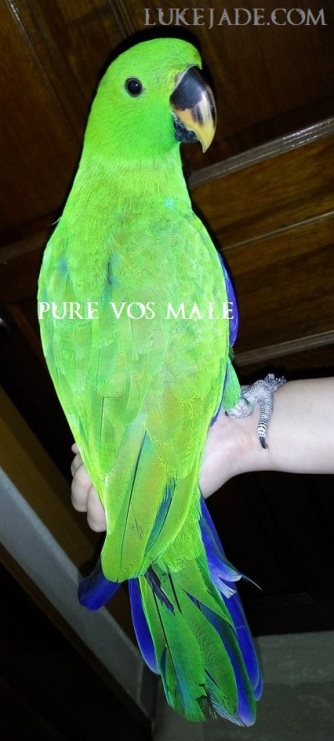


That’s plenty of tail to look at.
So how does one tell a male Vos (if not going into purity) from other subspecies?
- Tail length
- Tail contains a large amount of blue
- Least amount of yellow in the tail tips compared to other subs
- Beak and head shape
He is also a brighter green but many people have difficulty telling shades apart so I will not go much into that.
Another tail photo showing the blue amount:

And another showing the length of 165mm. There are variations in the lengths but a male Vos’ tail should not be something ridiculously short like 150mm. The tail tip has only a tinge of pale lemon. Faded yellow if you want simpler terms.
***Certain pure males may have a darker shade of yellow, in that case you would need to see his offspring to be sure of purity.***
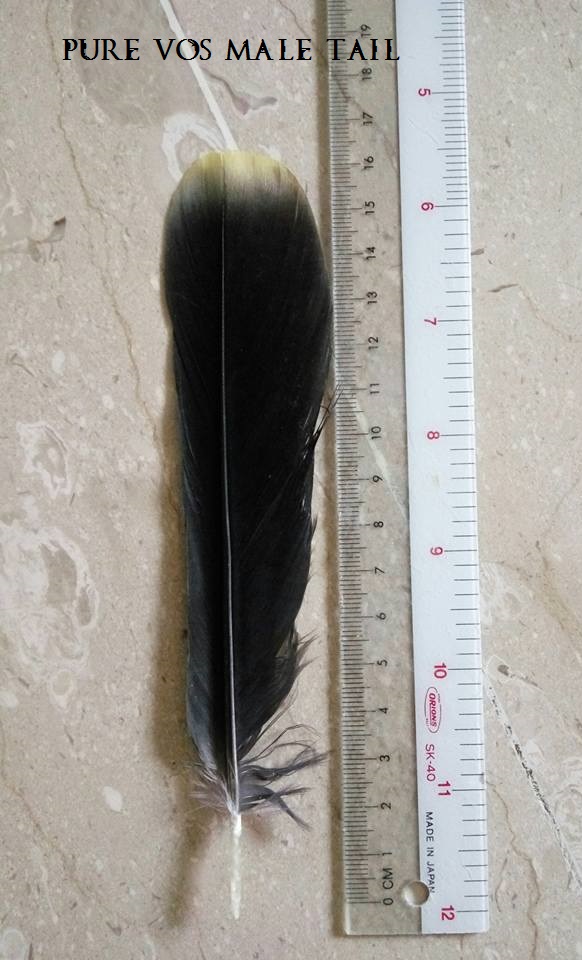
One of my favourite photos depicting the size difference between Vosmaeri and Solomons.

And we have the flat head with a small curved, elegant beak.
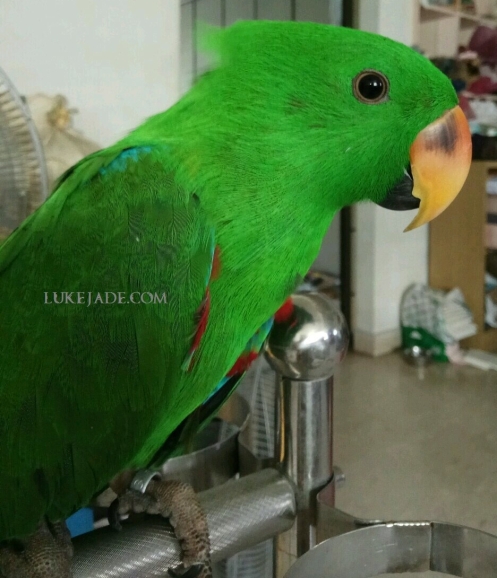
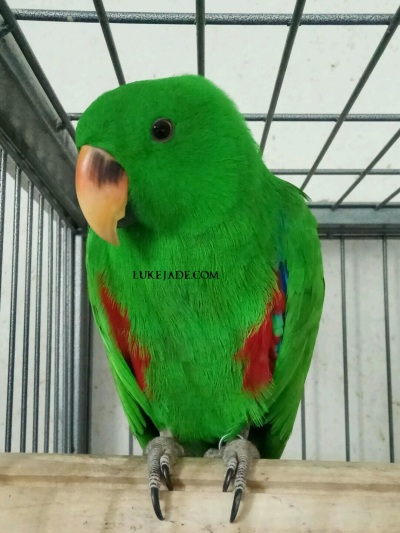
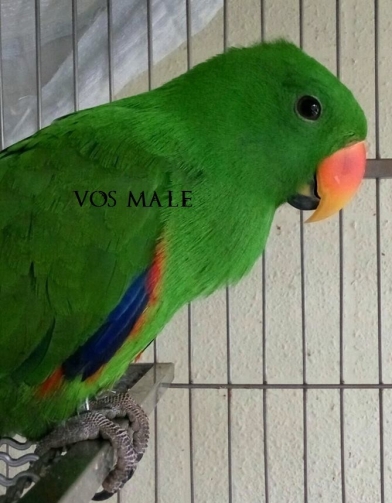
A male Vos’ beak should not curve out excessively like that of a Red Sided or Aruensis. If it does his purity is questionable.
Here are some photos of crossbred male Vos. They carry traits of pure birds, which is why it is safer to look at a female sibling in determining a male’s purity.
Both males below are crossbred Vos. The one on the right has the Vos beak shape and head. The left male has an oversized beak.
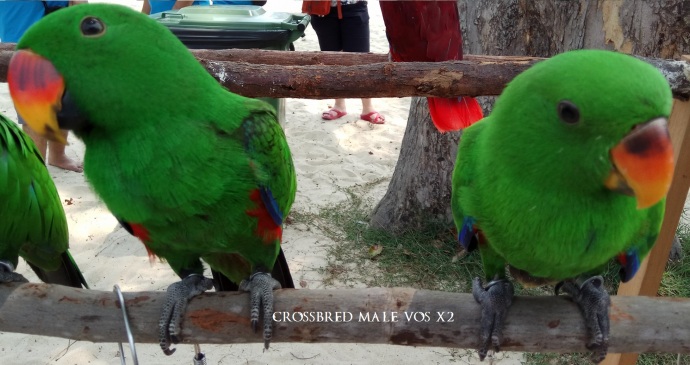
Bird on the right:
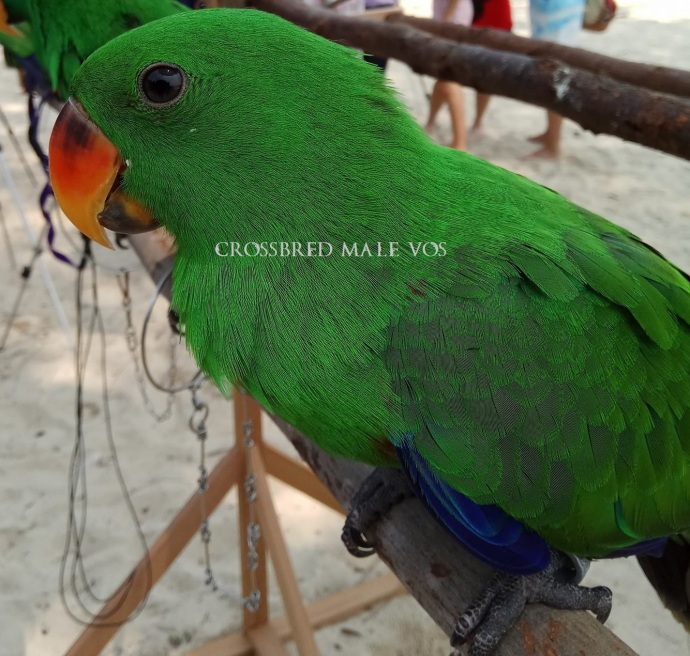
Tail of the male on the right. It has very little yellow. But not long enough to be a pure bird.
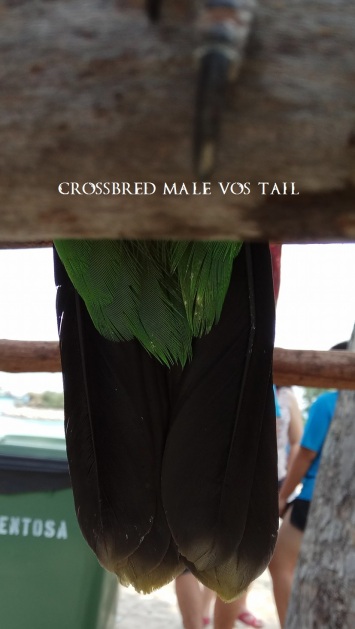
Check out the longer tail of the left crossbred which does not have a Vos beak shape.

The over-tails of both birds:
Bird on the right – the lack of blue amount and short tail length is very noticeable.

Tail of the bird on the left: Has a large amount of blue and length (but still not there).

Here is a full body shot of the bird on the left and also owner of the tail above.

Aside from having a larger beak than a Vos should have, it would have been hard to tell that he is a crossbred at that time when the photo was taken. The only clue you get from the above picture, is the bit of orange tinge on the tail tip. The Aru and Vos genes combined to form a lengthy tail.
Here is another crossbred male. The beak curves outward too excessively in proportion to his head to be appropriate for a Vos and the head is not as flat.

And his tail which is lacking in length.
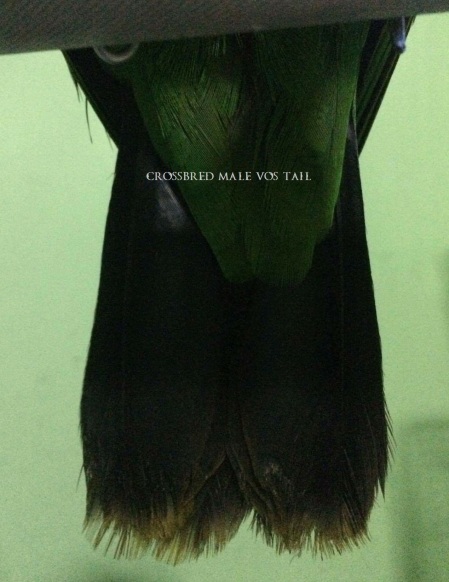

An observation of the crossbred males in this post, all of them have very little yellow tail tips. I’m referring to the under tail.
Now a little bit about the Aruensis males. Many people get them mixed up with the Vos because they are both long, almost the same shade of green and both have copious amounts of blue in the tail (the Vos have more). And their tail length is nearly equal.
Let photos do the talking! Left is a pure Vos, middle is an Aru cross and the right an Aru.
You can see the Vos is more luminescent green. Look at the beak differences. As for the yellow tail tips, the feathers are bunched together making it look like it contains more yellow.
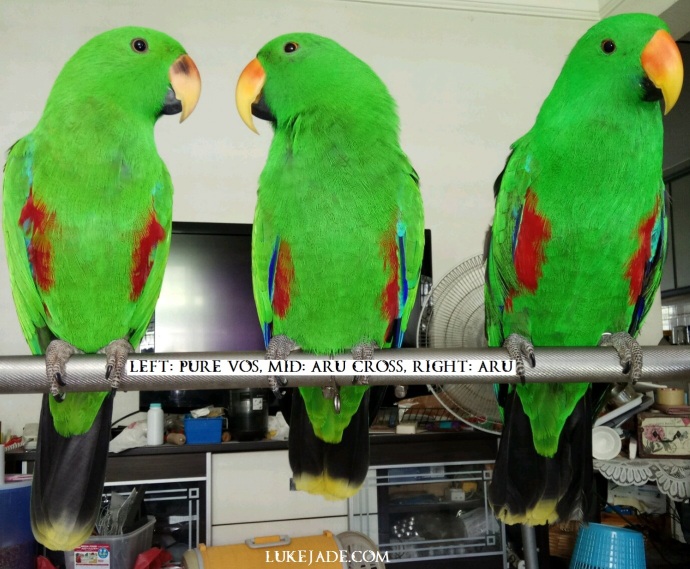
From the back. A length comparison. There are big and small (usually stunted instead of actually small) male Vos but some can be the length of Arus! You can see the Vos body is not so bulky.
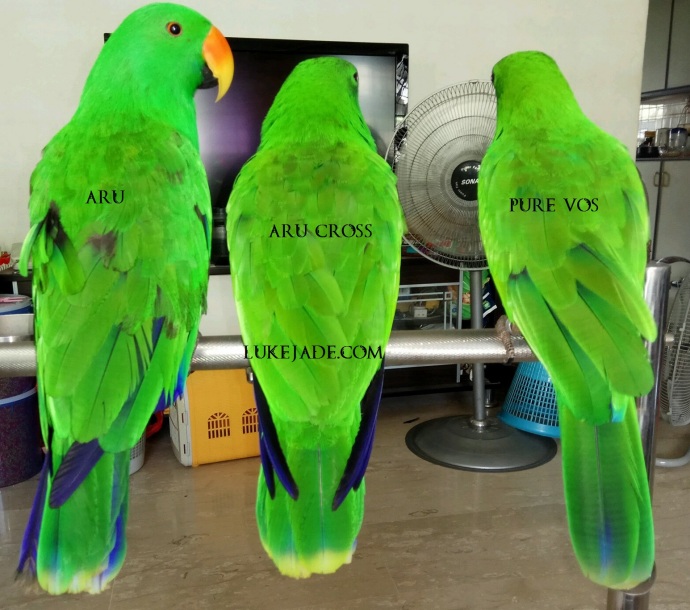
So what is the biggest difference between an Aru and Vos male? The tail tips. An Aru male has extensive yellow on his tail tips that a pure Vos does not have. Sometimes Arus also have other colours in their tails (which though is very common in Red Sided youngsters too, only the Arus sometimes keep their rainbow tails in maturity). A Vos male NEVER has any other colours in his tail tips but pale lemon be it youngster or mature.
This Aru male below is 4 years old at time of post. You would not believe me if you only looked at his beak markings.

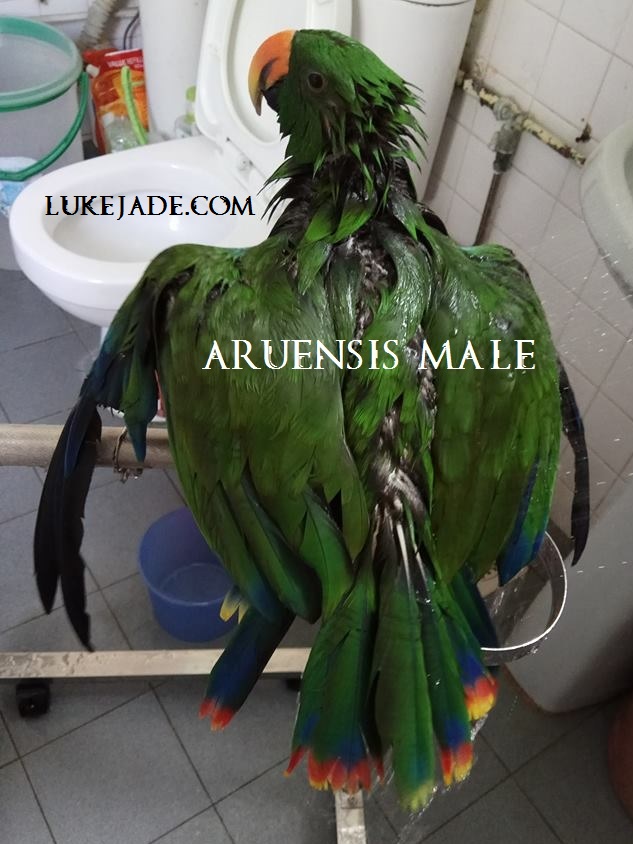
I will write about the Aruensis another time, hopefully. I do not have sufficient knowledge to safely show people beyond the basics.
A conclusion.
Part of why I wrote this article is because so many people have come forward saying they were offered a ‘pure’ Vos at a very good price or bought as a Vos but the birds turned out to be otherwise to their disappointment and $ loss. There are also more and more sellers claiming their birds are Vos or Aruensis in order to sell a higher price due to their supposed size. Beware also of smuggled birds, always buy a bird with a closed leg ring!
You need to be careful buying a Vos. Make sure the bird is at least 2 months old so you can gauge if they are pure. Look at the female sibling if buying a male. Better to see in person because photos can be stolen (I did not enjoy watermarking all over them!!).
If your male Vos is of unknown origin, say a shop or in a situation whereby you are unable to see a female sibling or even parents… you can guesstimate from how many traits your bird has. But no 100% sure until he is paired with a pure female and then observe his female offspring. If the daughter is pure, so is the father.
The average male Vos matures at 5 years up, therefore if you are breeding or intending to pair up please do as much research as you can on the parents and breeder. It would be terrible to wait until there is a chick and realise that the male is not pure and having to re-pair the birds.
There is only one other breeder at the moment of pure Vos, do contact me if you are keen to bring one of these magnificent birds home.
~
I would like to thank Rudy Caccia of Australia, Lisa Woodworth & Laurella Desborough of the United States of America for patiently teaching me about the Vosmaeri. You guys are awesome.

AoA, Hope you are enjoying the life with health and wealth. I appreciate of your working that you did very outstanding knowledge shared May Allah Bless you in the World & Hereafter.
Plz guide that how i can purchase the fertile eggs of Vosmeari Eclectus of some Reliable Source once again Thanks.
Regards
Nasir Afridi
Pakistan
LikeLike
Good day friend. I’m not from Pakistan I’m afraid, so I can’t help you on that 😦
LikeLike
So I have a female who we thought was an aruensis but noticed some slight vos traits and sure enough I found out who sold the pair to my breeder and she said the dad was the vos and the mom was an aru. Maybe a huge redsided and aru mixed but the tail screams aru. She barely had any yellow but what would you guess subspecies as well as if she will lose or gain yellow. She has a tip barley of yellow but it’s there. Nice if she did have more yellow! Where can I send you a pick? My email is truk1722@gmail.com
LikeLike
hey Kurt! Can you PM my FB page at https://www.facebook.com/lukejade/ ? I haven’t set up email here yet as they’re asking quite a bit of money.
LikeLike
Good morning,I have read your articles many times and it is very informative and in-depth. I do not have any parrot now. May I know where to buy a young pure VOS female. Do you have it? Thank you very much.
LikeLike
Hey Kent! Where’re you from?
LikeLike
Good afternoon, Kurt I am from Singapore.from Kent.
LikeLike
Kent, if you don’t mind untame and older birds you can message me at https://www.facebook.com/lukejade
There aren’t any pure babies available from anyone I know at the moment.
LikeLike
Good morning, Kurt. It is alright since there aren’t any VOS baby or young available. Thanks for the prompt reply.
LikeLike
Good morning, Kurt . How old is it now ? Where can I see it before I decide? Thanks.
LikeLike
Kent Lee. Right now we are not selling any pure vosmaeri as we are holding back youngsters to create a long term viable gene pool. There are too many cross bred birds in the US being put forward as vosmaeri. In many cases the breeder has not correctly identified these birds and does not know they are not pure vosmaeri.
LikeLike
Extremley great article. It is so important to know the differences between these birds. There are so many people out there that are telling us anything and everything just to sell a bird. I have a hen Eclectus that was given to me a year ago but I have know idea what spieces of Eclectus she is. She is a fairly large hen, the size of a large amazon or maybe just a bit larger. I’m thinking she maybe a Red Sided Eclectus but not really sure. I believe she is too big to be a Solomon Island. Thanks for posting the article, I’ve learned a great bit of information from this. Thanks again.
LikeLike
Have you any full front and side photos of her and her weight? It would help in determining what subspecies she is.
LikeLike
Truly a great article and was much needed and truly helped me a great deal. I can’t thank you enough. I talk to Lisa and laurella and they are amazing. Can’t wait to see if you publish one on the aruensis as that subspecies, as well, has a long way to go in true recognition! Thanks so much and what you shown is more then you know I believe. A true help!
Sincerely
Kurt
LikeLike
Very good article. It is especially important that pure vosmaeri are being bred. It seems that these birds are still being smuggled out of Indonesia and who knows what will be their destination and possible care. The vosmaeri subspecies is at risk and that makes it even more important to pair pure with pure.
LikeLike